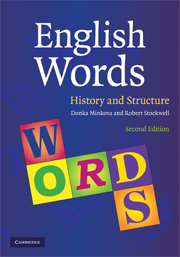Book contents
- Frontmatter
- Contents
- Preface to the second edition and acknowledgements
- An introduction to the textbook
- 1 Word-origins
- 2 The background of English
- 3 Composition of the Early Modern and Modern English Vocabulary
- 4 Smaller than words: morphemes and types of morphemes
- 5 Allomorphy, phonetics, and affixation
- 6 Replacement rules
- 7 Deletion rules and other kinds of allomorphy
- 8 Fossilized allomorphy: false cognates and other etymological pitfalls
- 9 Semantic relations and semantic change
- 10 The pronunciation of classical words in English
- Appendix: morpheme list
- Index
- References
4 - Smaller than words: morphemes and types of morphemes
Published online by Cambridge University Press: 05 June 2012
- Frontmatter
- Contents
- Preface to the second edition and acknowledgements
- An introduction to the textbook
- 1 Word-origins
- 2 The background of English
- 3 Composition of the Early Modern and Modern English Vocabulary
- 4 Smaller than words: morphemes and types of morphemes
- 5 Allomorphy, phonetics, and affixation
- 6 Replacement rules
- 7 Deletion rules and other kinds of allomorphy
- 8 Fossilized allomorphy: false cognates and other etymological pitfalls
- 9 Semantic relations and semantic change
- 10 The pronunciation of classical words in English
- Appendix: morpheme list
- Index
- References
Summary
The smallest meaningful units
We think of words as being the most basic, the most fundamental, units through which meaning is represented in language. There is a sense in which this is true. Words are the smallest free-standing forms that represent meaning. Any word can be cited as an isolated item. It can serve as the headword in a dictionary list. It can be quoted. It can be combined with other words to form phrases and sentences. In general the word is the smallest unit that one thinks of as being basic to saying anything. It is the smallest unit of sentence composition and the smallest unit that we are aware of when we consciously try to create sentences.
But actually there are even smaller units that carry the fundamental meanings of a language. Words are made up of these units. Consider just the unit gen inFigure 4.1. It is clearly not a free-standing word, but rather some kind of smaller unit which goes into the make-up, the composition, of words:
These smaller units are called morphemes. Gen is a morpheme. It has a basic single meaning ‘birth’ which has split into two distinct, yet related and overlapping meanings, ‘birth, origin’ and ‘tribe, stock, nation, type.’ Looking at the words that appear under each of these meanings, one can readily see the difference. The meaning ‘origin’ is most easily seen on the middle branch below it, in words like genetic or genital.
- Type
- Chapter
- Information
- English WordsHistory and Structure, pp. 63 - 82Publisher: Cambridge University PressPrint publication year: 2009



